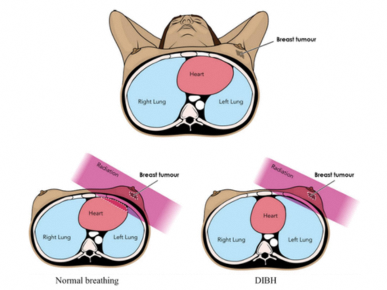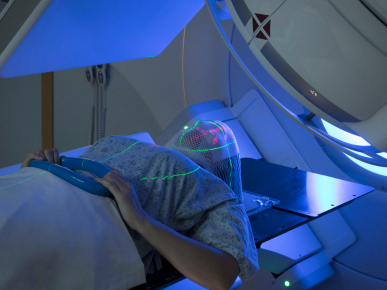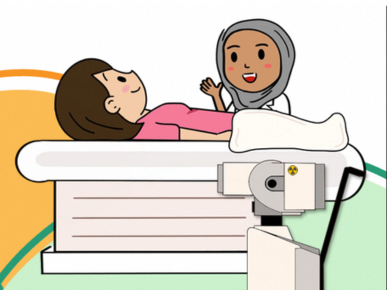Radiotherapy (Radiation Therapy) in Singapore
Radiation therapy (also called radiotherapy) uses targeted radiation to treat cancer and some non-cancerous conditions.
Radiation therapy (RT) or radiotherapy is the use of ionising radiation to treat patients with cancer and certain non-cancerous conditions. It works by damaging the DNA of cells and affecting their ability to multiply. Although radiation affects all cells, cancer cells are generally more sensitive to radiation damage. Each patient’s radiation treatment is carefully planned to minimise the radiation dose to nearby organs and healthy tissues.
Your treating doctor will tailor the type of radiation therapy based on your cancer type, stage of the disease, overall health, goals and preferences.
Depending on the cancer type and stage, radiation therapy can be used either alone or as part of the overall treatment. Radiation therapy may be used:
- To achieve remission or cure, radiation therapy can be used in different ways, often in combination with other treatment modalities like surgery and chemotherapy. It can be used as the primary means to eradicate the cancer without surgery, or it can be used before or after surgery to reduce the risk of a relapse.
- To control and relieve symptoms when cancer is not curable. For example, radiation therapy can control some cancers by making them smaller and delaying their growth and associated symptoms. It can also be used to reduce symptoms from cancer such as pain and bleeding.
Radiation Therapy can be used to cure or control cancer, and improve a patient’s quality of life by reducing symptoms caused by cancer.
- Cure – Radiotherapy can be used in different scenarios to help cure patients of cancer, often in combination with other treatment modalities like surgery and chemotherapy. It can be used as the primary means to eradicate the cancer without surgery, or it can be used before or after surgery to reduce the risk of a relapse.
- Control – Where it is not possible to cure a cancer, it may be possible to keep the cancer under control for some time. Radiation therapy can control some cancers by making them smaller and delaying their growth and associated symptoms.
- Palliation – Radiotherapy can also be used to reduce symptoms from cancer such as pain, and bleeding.
Learn more about how radiation therapy in Singapore helps patients manage cancer safely and effectively at the National Cancer Centre Singapore.
Radiation therapy can be given in two ways. The most common form is called External Beam Radiation Therapy (EBRT), where radiation is directed from the treatment machine to a particular area of the body. The other form is Internal Radiation Therapy or Brachytherapy where a small radioactive material is placed inside the body in or very close to the cancer.
Depending on the type of cancer, patients may be given just one form of radiation therapy or a combination of both.
- External Beam Radiation Therapy
During external beam radiation therapy (ERBT), the treatment unit or machine directs the radiation energy to the part of the body where the cancer is found. The radiation oncologist will assess each patient and recommend the type of radiation treatment that is most suitable.- Intensity Modulated Radiation Therapy (IMRT)
This is a form of 3D conformal radiotherapy that focuses multiple radiation beams onto the tumour. The beam intensities can be varied, so that the highest possible dose can be used to destroy cancerous tissue while sparing normal structures. Detailed planning is required to determine the most accurate treatment plan for each patient.
- Image-guided Radiation Therapy (IGRT)
IGRT uses imaging technologies to locate a tumour target before radiation therapy treatment. This process aims to improve treatment accuracy by reducing the need for large target margins. This minimises the amount of healthy tissue exposed to radiation and reduces side effects.
- Volumetric Modulated Arc Therapy (VMAT)
VMAT refers to the delivery of IMRT in a volumetric arc fashion. Treatment is delivered as the machine rotates 360 degrees around the patient through one or more arcs delivering radiation. The shape of the beam varies as the machine rotates to achieve a complex high dose volume in 3D to encompass the tumour.
- Stereotactic Radiosurgery and Radiotherapy System
This system of delivering radiation therapy combines the advantages of radiosurgery and IMRT with an image tracking guidance system to further enhance treatment accuracy. This involves an integrated treatment system that shapes focused high-energy radiation beams from a multitude of angles to deliver non-invasive, precise treatments that shrink or control the growth of tumour cells of the brain as well as in the head, neck, spine, liver, lung and prostate. The system can significantly reduce potential harm to surrounding normal tissue.
- Intensity Modulated Radiation Therapy (IMRT)
- 3-dimensional (3D) Internal Radiation therapy or Brachytherapy
Internal Radiation therapy or Brachytherapy is another form of radiation therapy where small radioactive material is placed in the body or very close to where the cancer is. This is commonly used in treating cancers of the cervix, uterus, vagina, head and neck regions, lung, breast and prostate. This treatment can be given alone or in combination with external beam radiation therapy.
The 3D image-based brachytherapy planning system increases the accuracy of brachytherapy, to reduce side effects and increase the dose to the target volume. During the procedure, CT and MRI images are used to allow the treating doctor to view the tumour size, match the treatment applicators accurately, and ensure an adequate dose of radiation is delivered to the targeted area while sparing normal, healthy tissues.
- Accelerated Partial Breast Irradiation (APBI) APBI is a breast conserving therapy approach for early-stage breast cancer which aims to kill remaining cancer cells after breast-conserving surgery. Radiation is delivered to the tumour site, instead of the whole breast. Normal organs around the tumour site such as the lungs, ribs heart and skin are spared irradiation. Suitable patients are selected based on the stage and aggressive nature of the tumour.
- Accelerated Partial Breast Irradiation (APBI) APBI is a breast conserving therapy approach for early-stage breast cancer which aims to kill remaining cancer cells after breast-conserving surgery. Radiation is delivered to the tumour site, instead of the whole breast. Normal organs around the tumour site such as the lungs, ribs heart and skin are spared irradiation. Suitable patients are selected based on the stage and aggressive nature of the tumour.
- Proton beam therapy
An advanced type of radiation treatment, proton therapy targets cancer cells using positively charged subatomic particles called protons. The unique physical properties of protons enable tumours to be more precisely targeted compared to the x-rays used in conventional radiotherapy. This minimises damage to nearby healthy tissues and organs and therefore results in fewer treatment-related side effects. It is most beneficial for patients who have cancers in sensitive areas like the head or neck and paediatric cancers.
NCCS is the only public healthcare institution in Singapore to offer proton therapy at the Goh Cheng Liang Proton Therapy Centre. For more information on proton therapy, click here.
Radiation therapy differs for each patient and can last from one day to a few weeks. For example, external radiation treatment is usually given once a day for 5 days from Monday to Friday, over a period of between 1 to 7 weeks.
Each dose of radiation causes incremental damage to the cancer cells. Therefore, it is important that patients complete the course of recommended treatment, as the total dose of radiation is needed to eventually kill the cancer cells.
Before the treatment:
You will first meet with the radiation oncologist who will discuss the best treatment course for you. Once the treatment has been determined, a series of appointments and procedures to prepare you for radiation therapy will be necessary. As almost all radiation therapy treatment is given in supine position, it is important to inform your radiation oncologist if you have difficulty lying down for a period of 30 to 45 minutes. Depending on the recommended treatment, patients may need one or more of the following procedures during the planning stage:
- Making of an immobilisation device
- Making of treatment accessories
- Localisation and marking of treatment area (Conventional or CT-Simulation)
The side effects of radiation therapy differ for each individual. The type of side effects depends on the part of the body being treated and the duration of the treatment. Some patients may have very mild or no side effects, while others may experience more severe side effects. Your general health can also affect how your body reacts to the treatment.
The most common side effects are fatigue, skin changes and/or loss of appetite. Other side effects are specific to the area of the body being treated. Inform your radiation oncologist or radiation therapist about any side effects that you experience during your weekly review. Most of these can be prevented, controlled or treated with medication.
- Possible side effects for patients receiving radiation to the head and neck areas
- Hair loss (Alopecia)
- Redness/sore scalp and ear canal
- Soreness of the mouth and/or throat, dry mouth, difficulty in swallowing
- Possible side effects for patients receiving radiation to the chest area
- Difficulty in swallowing
- Coughing and breathlessness
- Skin changes e.g. discolouration
- Possible side effects for patients receiving radiation to the breast area
- Skin changes e.g. red, sore and itchy skin
- Stiffness of the shoulder joint
- Possible side effects for patients receiving radiation to the abdominal area
- Loss of appetite, nausea and vomiting
- Bowel changes, abdominal discomfort and cramps
- Skin changes e.g. soreness, discolouration
- Possible side effects for patients receiving radiation to the pelvic area
- Bladder irritation e.g. discomfort and irritation when passing urine, more frequent urge to pass urine
- Bowel changes e.g. diarrhoea
- Skin changes e.g. red, sore itchy skin
- Possible side effects for patients receiving radiation to reproductive organs
- Fertility problems
- Intimacy and sexual concerns
The cost of radiation therapy depends on:
- The types and doses of radiation therapy used
- How long and how often radiation therapy is given
Based on your recommended treatment plan, your healthcare team will provide an estimated breakdown of the treatment cost and the subsidies available before you start treatment.

























